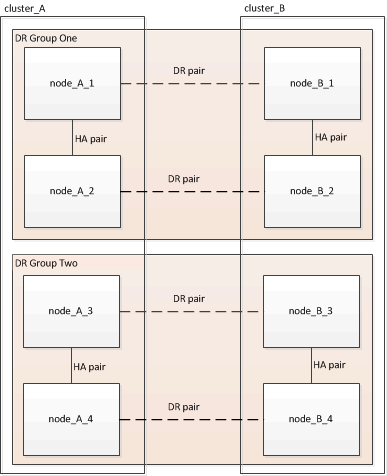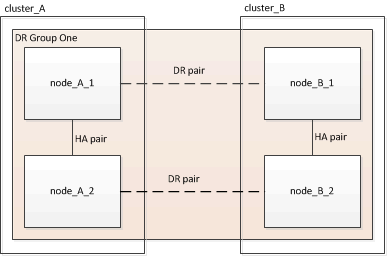Remove a DR group from a MetroCluster configuration
 Suggest changes
Suggest changes


Beginning with ONTAP 9.8, you can remove a disaster recovery (DR) group from an eight-node MetroCluster configuration to create a four-node MetroCluster configuration.

|
You use these steps during the transition and system refresh workflows. |
Enable console logging
NetApp strongly recommends that you enable console logging on the devices that you are using and take the following actions when performing this procedure:
-
Leave AutoSupport enabled during maintenance.
-
Trigger a maintenance AutoSupport message before and after maintenance to disable case creation for the duration of the maintenance activity.
See the Knowledge Base article How to suppress automatic case creation during scheduled maintenance windows.
-
Enable session logging for any CLI session. For instructions on how to enable session logging, review the "Logging Session Output" section in the Knowledge Base article How to configure PuTTY for optimal connectivity to ONTAP systems.
Remove the DR group nodes from each cluster
This procedure is supported beginning with ONTAP 9.8. For systems running ONTAP 9.7 or earlier, see the Knowledge Base article: How to remove a DR group from a MetroCluster configuration.
An eight-node configuration includes eight-nodes organized as two four-node DR groups.

When you remove a DR group, four nodes remain in the configuration.

-
You must perform this step on both clusters.
-
The
metrocluster remove-dr-groupcommand is supported only on ONTAP 9.8 and later.
-
Prepare to remove the DR group if you have not already.
-
Move all data volumes to another DR group.
-
If the DR group to be removed has load-sharing mirror volumes, re-create all load-sharing mirror volumes in another DR group and delete them from the DR group to be removed.
-
Move all MDV_CRS metadata volumes to another DR group by following the Moving a metadata volume in MetroCluster configurations procedure.
-
Delete all MDV_aud metadata volumes that might exist in the DR group to be removed.
-
Delete all data aggregates in the DR group to be removed:
ClusterA::> storage aggregate show -node ClusterA-01, ClusterA-02 -fields aggregate ,node ClusterA::> aggr delete -aggregate aggregate_name ClusterB::> storage aggregate show -node ClusterB-01, ClusterB-02 -fields aggregate ,node ClusterB::> aggr delete -aggregate aggregate_name
Root aggregates are not deleted. -
Migrate all NAS data LIFs that you use for NFS and CIFS (SMB) to home nodes in another DR group.
network interface show -home-node <old_node>network interface migrate -vserver <svm_name> -lif <data_lif> -destination-node <new_node> -destination-port <port> -
Move the data LIFs to the new home node in another DR group.
network interface modify -vserver <svm-name> -lif <data-lif> -home-node <new_node> -home-port <port> -
Migrate the cluster management LIF to a home node in another DR group.
network interface show -role cluster-mgmtnetwork interface modify -vserver <svm-name> -lif <cluster_mgmt> -home-node <new_node> -home-port <port-id>-
Node management and inter-cluster LIFs are not migrated. Create new node management and inter-cluster LIFs on nodes of the DR group as required.
-
You cannot migrate or move FCP interfaces used for block access (SAN) between the nodes. Create new FCP interfaces as needed.
-
iSCSI SAN LIFs need to be down before the home node and home port can be updated.
-
-
Transfer epsilon to a node in another DR group if required.
ClusterA::> set advanced ClusterA::*> cluster show Move epsilon if needed ClusterA::*> cluster modify -node nodename -epsilon false ClusterA::*> cluster modify -node nodename -epsilon true ClusterB::> set advanced ClusterB::*> cluster show ClusterB::*> cluster modify -node nodename -epsilon false ClusterB::*> cluster modify -node nodename -epsilon true ClusterB::*> set admin
-
-
Identify and remove the DR group.
-
Identify the correct DR group for removal:
metrocluster node show -
Remove the DR group nodes:
metrocluster remove-dr-group -dr-group-id 1The following example shows the removal of the DR group configuration on cluster_A.
Example
cluster_A::*> Warning: Nodes in the DR group that are removed from the MetroCluster configuration will lose their disaster recovery protection. Local nodes "node_A_1-FC, node_A_2-FC"will be removed from the MetroCluster configuration. You must repeat the operation on the partner cluster "cluster_B"to remove the remote nodes in the DR group. Do you want to continue? {y|n}: y Info: The following preparation steps must be completed on the local and partner clusters before removing a DR group. 1. Move all data volumes to another DR group. 2. Move all MDV_CRS metadata volumes to another DR group. 3. Delete all MDV_aud metadata volumes that may exist in the DR group to be removed. 4. Delete all data aggregates in the DR group to be removed. Root aggregates are not deleted. 5. Migrate all data LIFs to home nodes in another DR group. 6. Migrate the cluster management LIF to a home node in another DR group. Node management and inter-cluster LIFs are not migrated. 7. Transfer epsilon to a node in another DR group. The command is vetoed if the preparation steps are not completed on the local and partner clusters. Do you want to continue? {y|n}: y [Job 513] Job succeeded: Remove DR Group is successful. cluster_A::*>
-
-
Repeat the previous step on the partner cluster.
-
Disable storage failover on the nodes of the old DR group:
storage failover modify -node <node-name> -enable false -
If you are in a MetroCluster IP configuration, perform the following steps to delete the remote plexes of the root aggregates and remove disk ownership on the nodes of the old DR group.
These steps need to be performed for both nodes in the HA pair at each site.
-
Display the remote plexes of root aggregates on the nodes in the DR group that is to be deleted:
storage aggregate plex show -aggregate <root_aggr_name> -pool 1 -
Delete the remote plexes:
storage aggregate plex delete -aggregate <root_aggr_name> -plex <plex_from_previous_step> -
Identify the remote disks owned by the nodes in the DR group.
The commands you use depend on whether you are using partitioned/shared disks or whole disks:
Use a comma-separated list in the -owner <node_names>field to specify the node names in the DR group that is to be deleted.Partitioned/shared disks:-
Set the privilege level to advanced:
set advanced -
Display the remote disks:
storage disk show -pool Pool1 -owner <node_names> -partition-ownership
Whole disks:-
Set the privilege level to advanced:
set advanced -
Display the remote disks:
storage disk show -pool Pool1 -owner <node_names>
-
-
Disable disk auto assignment:
disk option modify -node <node_names_in_the_DR_group_to_be_deleted> -autoassign off -
Remove ownership of pool1 disks on each DR group node to be deleted. Perform these steps on each node to be removed.
-
Go to the nodeshell:
run -node <node_name> -
Identify the pool1 disks:
aggr status -sAll spare disks are displayed, including the pool0 and pool1 spare disks owned by the node.
-
Remove disk ownership for each pool1 spare disk:
disk remove_ownership <disk_name>For partitioned disks, remove partition ownership and then remove the container disk ownership.
-
-
-
If you are in a MetroCluster IP configuration, remove the MetroCluster connections on the nodes of the old DR group.
These commands can be issued from either cluster and apply to the entire DR group spanning both of the clusters.
-
Disconnect the connections:
metrocluster configuration-settings connection disconnect -dr-group-id <dr_group_id>Example
cluster_A::*> metrocluster configuration-settings connection disconnect -dr-group-id 1 Warning: For the nodes in the DR group 1, this command will remove the existing connections that are used to mirror NV logs and access remote storage. Do you want to continue? {y|n}: y Warning: Before proceeding with disconnect, you must verify the following: 1. Unmirrored aggregates do not have disks in remote plexes. 2. Aggregates are not mirrored. 3. No disks are assigned in Pool1. 4. Storage failover is not enabled. Follow the "MetroCluster Installation and Configuration guide" for detailed instructions to verify this. Do you want to continue? {y|n}: y -
Delete the MetroCluster interfaces on the nodes of the old DR group:
This step must be repeated on each node of the DR group. metrocluster configuration-settings interface delete -
Delete the old DR group's configuration.
metrocluster configuration-settings dr-group delete
-
-
Unjoin the nodes in the old DR group.
Perform this step on each cluster.
-
Set the advanced privilege level:
set -privilege advanced -
Unjoin the node:
cluster unjoin -node <node-name>Repeat this step for the other local node in the old DR group.
-
Set the admin privilege level:
set -privilege admin
-
-
Check that cluster HA is enabled in the new DR group. If required, re-enable cluster HA:
cluster ha modify -configured truePerform this step on each cluster.
-
Halt, power down, and remove the old controller modules and storage shelves.


